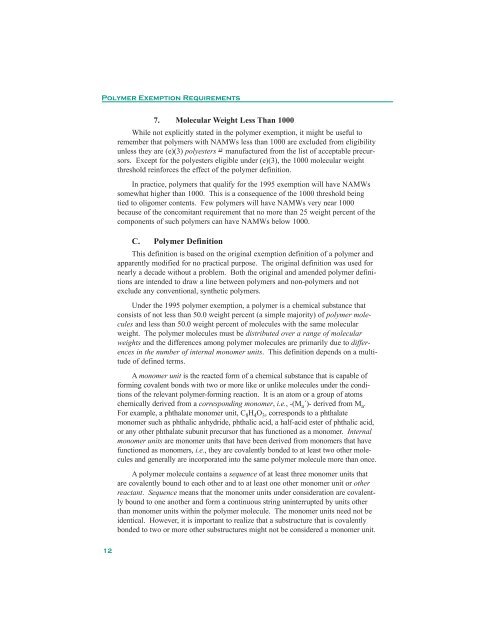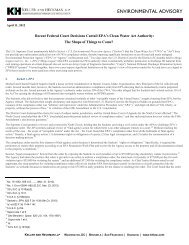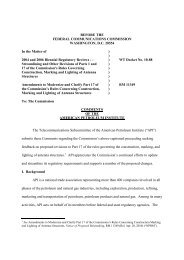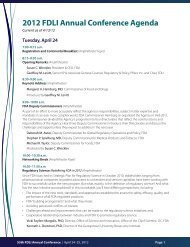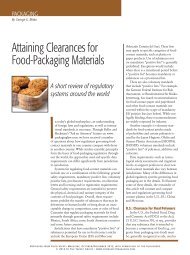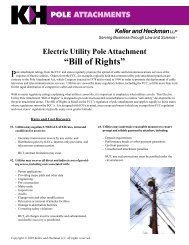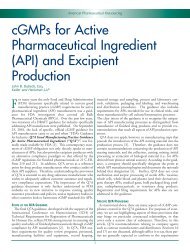A Practical Understanding of the Polymer ... - Keller Heckman
A Practical Understanding of the Polymer ... - Keller Heckman
A Practical Understanding of the Polymer ... - Keller Heckman
You also want an ePaper? Increase the reach of your titles
YUMPU automatically turns print PDFs into web optimized ePapers that Google loves.
<strong>Polymer</strong> Exemption Requirements<br />
7. Molecular Weight Less Than 1000<br />
While not explicitly stated in <strong>the</strong> polymer exemption, it might be useful to<br />
remember that polymers with NAMWs less than 1000 are excluded from eligibility<br />
unless <strong>the</strong>y are (e)(3) polyesters 13/ manufactured from <strong>the</strong> list <strong>of</strong> acceptable precursors.<br />
Except for <strong>the</strong> polyesters eligible under (e)(3), <strong>the</strong> 1000 molecular weight<br />
threshold reinforces <strong>the</strong> effect <strong>of</strong> <strong>the</strong> polymer definition.<br />
In practice, polymers that qualify for <strong>the</strong> 1995 exemption will have NAMWs<br />
somewhat higher than 1000. This is a consequence <strong>of</strong> <strong>the</strong> 1000 threshold being<br />
tied to oligomer contents. Few polymers will have NAMWs very near 1000<br />
because <strong>of</strong> <strong>the</strong> concomitant requirement that no more than 25 weight percent <strong>of</strong> <strong>the</strong><br />
components <strong>of</strong> such polymers can have NAMWs below 1000.<br />
C. <strong>Polymer</strong> Definition<br />
This definition is based on <strong>the</strong> original exemption definition <strong>of</strong> a polymer and<br />
apparently modified for no practical purpose. The original definition was used for<br />
nearly a decade without a problem. Both <strong>the</strong> original and amended polymer definitions<br />
are intended to draw a line between polymers and non-polymers and not<br />
exclude any conventional, syn<strong>the</strong>tic polymers.<br />
Under <strong>the</strong> 1995 polymer exemption, a polymer is a chemical substance that<br />
consists <strong>of</strong> not less than 50.0 weight percent (a simple majority) <strong>of</strong> polymer molecules<br />
and less than 50.0 weight percent <strong>of</strong> molecules with <strong>the</strong> same molecular<br />
weight. The polymer molecules must be distributed over a range <strong>of</strong> molecular<br />
weights and <strong>the</strong> differences among polymer molecules are primarily due to differences<br />
in <strong>the</strong> number <strong>of</strong> internal monomer units. This definition depends on a multitude<br />
<strong>of</strong> defined terms.<br />
A monomer unit is <strong>the</strong> reacted form <strong>of</strong> a chemical substance that is capable <strong>of</strong><br />
forming covalent bonds with two or more like or unlike molecules under <strong>the</strong> conditions<br />
<strong>of</strong> <strong>the</strong> relevant polymer-forming reaction. It is an atom or a group <strong>of</strong> atoms<br />
chemically derived from a corresponding monomer, i.e., -(M a´)- derived from M a .<br />
For example, a phthalate monomer unit, C 8 H 4 O 3 , corresponds to a phthalate<br />
monomer such as phthalic anhydride, phthalic acid, a half-acid ester <strong>of</strong> phthalic acid,<br />
or any o<strong>the</strong>r phthalate subunit precursor that has functioned as a monomer. Internal<br />
monomer units are monomer units that have been derived from monomers that have<br />
functioned as monomers, i.e., <strong>the</strong>y are covalently bonded to at least two o<strong>the</strong>r molecules<br />
and generally are incorporated into <strong>the</strong> same polymer molecule more than once.<br />
A polymer molecule contains a sequence <strong>of</strong> at least three monomer units that<br />
are covalently bound to each o<strong>the</strong>r and to at least one o<strong>the</strong>r monomer unit or o<strong>the</strong>r<br />
reactant. Sequence means that <strong>the</strong> monomer units under consideration are covalently<br />
bound to one ano<strong>the</strong>r and form a continuous string uninterrupted by units o<strong>the</strong>r<br />
than monomer units within <strong>the</strong> polymer molecule. The monomer units need not be<br />
identical. However, it is important to realize that a substructure that is covalently<br />
bonded to two or more o<strong>the</strong>r substructures might not be considered a monomer unit.<br />
12


